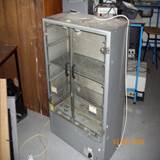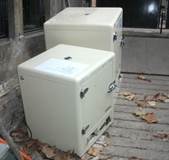- About Asbestos
- Asbestos Used in Buildings
- Asbestos Used in Equipment
- Managing Asbestos in situ versus Removal
- Asbestos Glossary
- Legislation
- Types of Asbestos Survey
- Useful links
About Asbestos
Asbestos is a term used for a group of naturally occurring, fibrous minerals. The main types of asbestos commercially used are:
- Crocidolite (blue)
- Amosite (brown)
- Chrysotile (white)
Asbestos was used extensively in building materials, especially from the 1950s through to the mid-1980s in the UK. It was used in new build, refurbishment and building improvement projects. It was known as the miracle fibre due to its versatility.
Subject to gradual prohibition, by 1999 the importation, supply and use of all forms of asbestos had been banned in the UK.
All forms of asbestos are treated equally under current UK legislation.
The hazards to health arising from asbestos exposure are well known. It is worth noting that a background level of asbestos fibre is regarded as inherent to the UK’s environment; it is exposures caused by activities such as uncontrolled / unintentional asbestos work that are believed to be the significant risk factor for onset of asbestos related disease.
Asbestos Used in Buildings
Asbestos has been reputedly used in 3500 various products. Some common locations of various asbestos materials used in buildings are available from the HSE.
https://www.hse.gov.uk/asbestos/location-materials.htm
Asbestos Used in Equipment
Asbestos use was not limited to buildings / construction; it was also widely used in equipment e.g. insulating materials, gaskets, washers and other component parts etc.
Example Applications:
- insulation of pipes, boilers, pressure vessels, calorifiers, etc.
- heat insulation and fire protection in switchgear
- electrical / heat insulation of electrical equipment, wiring, ovens etc.
- acoustic linings in air handling equipment; duct and pipe insulation
- lagging, jointing, packing materials for heat resistance or fire protection
- cloth used as thermal insulation and lagging, including blankets, mattresses, protective curtains, gloves, aprons, overalls (including aluminium coated)
- gaskets and washers
- strings e.g. for sealing hot water radiators
- friction products e.g. brakes and clutch plates
- drive belts and conveyor belts
- laboratory worktops
- flue pipes, extractor hoods
- underseals
- asbestos gloves or those with asbestos lining
Examples of equipment where asbestos containing materials have been known to be utilised as constructional elements or component parts:
 |
 |
 |
| Fume Cupboards | Incubators | Ovens |
Asbestos Management surveys carried out on the Estate would attempt to identify asbestos in equipment where possible. However, it should be noted that this is generally considered an impractical undertaking, not covered comprehensively within the Register and should be regarded as a survey limitation.
When working on equipment, further information may be required in addition to that provided within the Asbestos Register; clarification should be sought in the first instance from:
|
ED Asbestos Team Department |
Managing Asbestos in situ versus Removal
It is important to emphasise that asbestos is only dangerous when disturbed. HSE guidance, such as INDG223, ‘Managing asbestos in buildings’ clearly states that safely managed asbestos does not present a health hazard, suitable materials can be managed in situ and that unnecessary removal can sometimes be more dangerous than leaving it in place and managing it.
In addition, for some types of building construction the asbestos is so intrinsic to the structure it cannot be fully removed until at the time of building demolition.
Removal of asbestos is an appropriate course of action if:
- the material presents a risk
- the material cannot be managed in situ
- removal of the material is a requirement of maintenance, refurbishment or any other works affecting the building.
- removal is required for any other legitimate reason.
Asbestos Glossary
Legislation
There are many health and safety regulations that either directly or indirectly place a duty on the employer with regards to asbestos. An outline of key regulations is given below:
The Health & Safety at Work etc. Act: requires employers to conduct their work in such a way that their employees will not be exposed to health and safety risks, and to provide information to other people about their workplace which might affect their health and safety. Section 3 of the HSW Act contains general duties on employers and the self-employed in respect of people other than their own employees. Section 4 contains general duties for anyone who has control, to any extent, over a workplace;
The Management of Health & Safety at Work Regulations: requires employers and self-employed people to make an assessment of the risks to the health and safety of themselves, employees and people not in their employment, arising out of or in connection with the conduct of their business, and to make appropriate arrangements for protecting those people’s health and safety. Any assessment made for the purposes of the Asbestos Regulations will not need to be repeated for the Management Regulations;
The Workplace (Health, Safety and Welfare) Regulations:requires employers to maintain workplace buildings so as to protect occupants and workers;
The Construction (Design & Management) Regulations: are about focusing attention on effective planning and management of construction projects, from design concept onwards. The aim is for health and safety considerations to be treated as a normal part of a project’s development, not an afterthought or bolt-on extra. The object of the CDM 2015 Regulations is to reduce the risk of harm to those that have to build, use, maintain and demolish structures.
The Defective Premises Act (England and Wales): places duties on landlords to take reasonable care to see that tenants and other people are safe from personal injury or disease caused by a defect in the state of the premises. Any premises in such a state as to be prejudicial to health constitute a statutory nuisance under section 79 of the Environmental Protection Act 1990. An abatement notice can be served by the local authorities on the owner or occupier of premises requiring prevention or restriction of the nuisance;
The Control of Asbestos Regulations: requires employers to prevent the exposure of their employees to asbestos, or where this is not practicable, to reduce the exposure to the lowest possible level.
Regulation 4 (the duty to manage asbestos) specifically requires duty holders to:
a) Take reasonable steps to find materials in premises likely to contain asbestos and to check their condition.
b) Presume that materials contain asbestos unless there is strong evidence to suppose that they do not.
c) Make a written record of the location and condition of asbestos and presumed Asbestos Containing Materials and keep the record up to date.
d) Assess the risk of the likelihood of anyone being exposed to these materials.
e) Prepare a plan to manage that risk and put it into effect to ensure that:
Any material known or presumed to contain asbestos is kept in a good state of repair;
Any material that contains or is presumed to contain asbestos is, because of the risks associated with its location or condition, repaired or if necessary removed;
Information on the location and condition of the material is given to anyone potentially at risk.
The Hazardous Waste (England and Wales) Regulations: Asbestos materials must be disposed of as hazardous waste and must not enter normal waste streams. These regulations cover the detailed requirements for the transport, treatment, storage and disposal of hazardous waste.
Types of Asbestos Survey
There are two types of asbestos survey and each has specific applications:
- Management Survey
- Refurbishment / Demolition Survey
A full description is given in HSE’s official guidance: HSG264 Asbestos: The survey guide.
HSG264 replaces MDHS100 and some of the updates are given below:
1) Type 1 & 2 Surveys are now called Management Surveys and Type 3 Surveys are now called Refurbishment and Demolition Surveys.
|
Asbestos Management Surveys are undertaken to assist with the management of asbestos risk in buildings under normal occupancy. Asbestos Refurbishment / Demolition Surveys are undertaken to identify asbestos where building fabric (or fixed plant) will be disturbed/ altered. |
2) Emphasis has been placed on the planning phase of the survey. Consultants should make enquiries for a range of information at the tender / enquiry stage so that a detailed quotation and risk assessment can be provided. Consultants must prepare a suitable method statement and assessment to undertake the asbestos survey, especially for Refurbishment / Demolition surveys.
3) The survey planning phase should also aim to reduce the amount of caveats used and areas of no access. Caveats must be agreed in advance and detailed fully in correspondence.
4) Asbestos Refurbishment / Demolition surveys may require opening up techniques and designated asbestos work areas similar to those that are employed in asbestos removal work. Areas for inspection should be vacant and may require reassurance air monitoring before being re-occupied, especially if significant opening up has been necessary.
5) Surveys should be carried out by teams of 2 surveyors, where practicable.
6) The guidance details the levels of accreditation and quality that is necessary, in particular use of UKAS accredited laboratories.
For further information on asbestos surveys and management of asbestos in University buildings, please contact the EM Asbestos Team.
Useful links
- HSE's web pages - general information and links to HSE campaigns
- View the Control of Asbestos Regulations 2012 (CAR2012)
- Disposal of asbestos materials or any item containing asbestos is regulated as a Hazardous Waste
- Trade association for the Asbestos Consultants - Asbestos Consultant and Testing Association and Asbestos Removal Contractors – ARCA or ACAD
- Checks to ensure asbestos surveyors or analysts are meeting UKAS accredited requirements surveyors or analysts.
